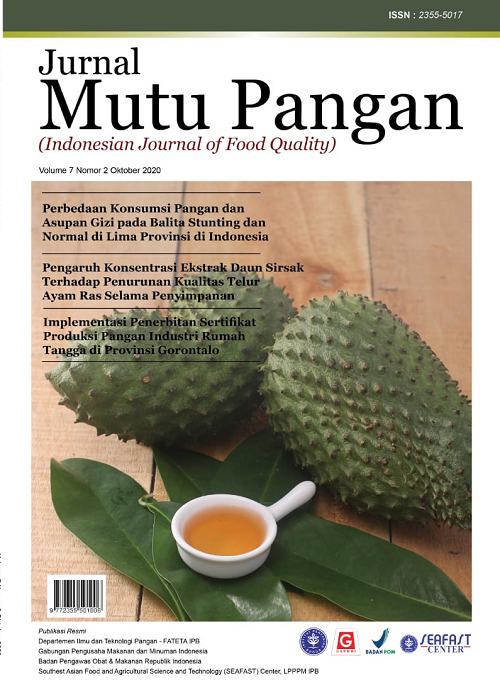Perbedaan Konsumsi Pangan dan Asupan Gizi pada Balita Stunting dan Normal di Lima Provinsi di Indonesia
Abstract
Stunting is an important sign of chronic malnutrition that exists in early life with greater infection risk and with many long-term effects, including the need for physical work. Stunting is a problem for the Indonesian people to produce a generation that has global competitiveness. In general, this study aims to determine the effect of food consumption on the adequacy and balance of nutrition between stunted and normal children in 5 provinces in Indonesia. Specifically, this study aims to (1) lassify toddlers based on height according to age in the stunting and normal categories, (2) get a profile of stunting and normal toddler food consumption, (3) analyze data on nutrient intake and food contribution in the stunting group and normal, (4) analyze data on the adequacy and balance of nutrition from food intake in stunting and normal children under five in 5 provinces in Indonesia. This study used secondary data of food consumption data from SKMI 2014 and anthropometric data from Riskesdas 2013 of West Java, Central Java, East Java, West Nusa Tenggara and East Nusa Tenggara provinces. There were 2,039 samples from 5 provinces, 38.4% of them were stunting toddlers. Food consumption of toddlers with normal height was higher than stunting toddlers for eggs and egg products and lower for sugars. Intake of calcium and vitamin A in normal toddlers was significantly higher than stunting toddlers and lower for vitamin C. Both stunting and normal children groups showed deficiency, sufficiency and excess in nutrient intake. Imbalance nutrient intake for both stunting and normal children reached 100%.
Downloads
References
[ASEAN] Association of Southeast Asian Nations. 2014. ASEAN Food Composition Database. ASEANFOOD Regional Centre and INFOODS Regional Database Centre, Bangkok.
Burckhardt P, Dawson-Hughes B, Weaver C. 2010. Nutritional Influences on Bone Health. Springer, New York. DOI: 10.1007/978-1-84882-978-7.
Cruz LMG, Azpeitia GG, Súarez DR, Rodríguez AS, Ferrer JFL, Serra-Majem L. 2017. Factors associated with stunting among children aged 0 to 59 months from the Central Region of Mozambique. Nutr 9(5): 491-506.DOI:10.3390/nu9050491.
Dewey GK. 2001. Nutrition, growth, and complementary feeding of breastfed infant. Ped Clin North America 48(1): 87-104. DOI: 10.1016/S0031-3955(05)70287-X.
Gibson RS, Manger MS, Krittaphol W, Pongcharoen T, Gowachirapant S, Winichagoon P. 2007. Does zinc deficiency play a role in stunting among primary school children in Thailand. Br J Nutr 97(1): 167-175. DOI: 10.1017/S0007114507250445.
Iannotti LL, Lutter CK, Stewart CP, Riofrio CAG, Malo C, Reinhart G, Palacios A, Karp C, Chapnick M, Cox K, Waters WF. 2017. Eggs in early complementary feeding and child growth: a randomized controlled trial. Pediatrics 140(1): e20163459. DOI: 10.1542/ peds.2016-3459.
[Kemenkes] Kesehatan RI. 2020. Peraturan Menteri Kesehatan RI No. 2 tahun 2020 tentang Standar Antropometri Balita. Kemenkes, Jakarta.
[Kemenkes] Kementerian Kesehatan RI. 2013a. Riset Kesehatan Dasar 2013. Kemenkes, Jakarta.
[Kemenkes] Kementerian Kesehatan RI. 2013b. Pera-turan Menteri Kesehatan Republik Indonesia No.75 Tahun 2013 tentang Angka Kecukupan Gizi yang Dianjurkan bagi Bangsa Indonesia. Kemenkes, Jakarta.
[Kemenkes] Kementerian Kesehatan RI. 2014. Buku Studi Diet Total: Survei Konsumsi Makanan Indi-vidu. Kemenkes, Jakarta.
[Kemenkes] Kementerian Kesehatan RI. 2018. Riset Kesehatan Dasar 2018. Kemenkes, Jakarta.
Maggini S, Pierre A, Calder PC. 2018. Review immune function and micronutrient requirements change over the life course. Nutr 10(10): 1531. DOI: 10.3390/ nu10101531.
McCrory MA, Campbell WW. 2011. Effect of eating frequency, snacking, and breakfast skipping on energy regulation. J Nutr 141(1): 144-147. DOI: 10.3945/jn.109.114918.
Mikhail WZA, Sabhy HM, El-sayed HH, Khairy SA, Salem HYHA, Samy MA. 2013. Effect of nutritional status on growth pattern of stunted preschool children in Egypt. Acad J Nutr 2(1): 1-9. DOI: 10.5829/ idosi.ajn.2013.2.1.7466.
Motbainor A, Worku A, Kumie A. 2015. Stunting is associated with food diversity while wasting with food insecurity among underfive children in East and West Gojjam Zones of Amhara Region, Ethiopia. PLoS ONE 10(8): e0133542. DOI: 10.1371/journal. pone.0133542.
O’Neil CE, Fulgoni III VL, Nicklas TA. 2011. Association of candy consumption with body weight measures, other health risk factors for cardiovascular disease, and diet quality in US children and ado-lescents: NHANES 1999-2004. Food Nutr Res 55: 5794.
DOI:10.3402/fnr.v55i0.5794.
Ravisankar P, Reddy AA, Nagalakshmi B Koushik OS, Kumar BV, Anvith PS. 2015. The comprehensive review on fat soluble vitamins. IOSR J Pharm 5(11): 12-28.
Sanin KI, Islam MM, Mahfuz M, Ahmed AMS, Mondal D, Haque R, Ahmed T. 2018. Micronutrient ade-quacy is poor, but not associated with stunting between 12-24 months of age: A cohort study findings from a slum area of Bangladesh. PLoS ONE 13(3): e0195072. DOI: 10.1371/journal.pone.019 5072.
Sari EM, Juffrie M, Nurani N, Sitaresmi MN. 2018. Asupan protein, kalsium dan fosfor pada balita stunting dan tidak stunting usia 24-59 bulan. J Gizi Klinik Indonesia 12(4): 152-159. DOI: 10.22146/ ijcn.23111.
Ssentongo P, Ba DM, Ssentongo AE, Fronterre C, Whalen A, Yang Y, Ericson JE, Chinchilli VM. 2020. Association of vitamin A deficiency with early childhood stunting in Uganda: A population-based cross-sectional study. PLoS ONE 15(5): e0233615. DOI: 10.1371/journal. pone.0233615.
Stuijvenberg ME, Nel J, Schoeman SE, Lombard CJ, du Plessis LM, Dhansay MA. 2015. Low intake of calcium and vitamin D, but not zinc, iron or vitamin A, is associated with stunting in 2-5 years old children. Nutr 31: 841-846. DOI: 10.1016/j.nut.2014. 12.011.
Theron M, Amissah A, Kleynhans I, Albertse E, MacIntyre U. 2007. Inadequate dietary intake is not the cause of stunting amongst young children living in an informal settlement in Gauteng and rural Lim-popo Province in South Africa: the NutriGro study. Pub Health Nutr 10: 379–389. DOI:10.1017/ S1368980007246579.
[TNP2K] Tim Nasional Percepatan Penanggulangan Kemiskinan. 2017. 100 Kota/Kabupaten Prioritas Untuk Inversi Balita Kerdil (Stunting). TNP2K, Jakarta.
Valentina V. 2014. Kontribusi Pangan Terhadap Asupan dan Status Gizi Kalsium dan Vitamin D pada Balita Indonesia Usia 2 sampai dengan 12 Tahun. [Tesis]. Bogor: Sekolah Pascasarjana, Institut Pertanian Bogor.
[WHO] World Health Organization. 2014. Global Nutrition Target 2025: Stunting Policy Brief. Geneva: WHO.

















